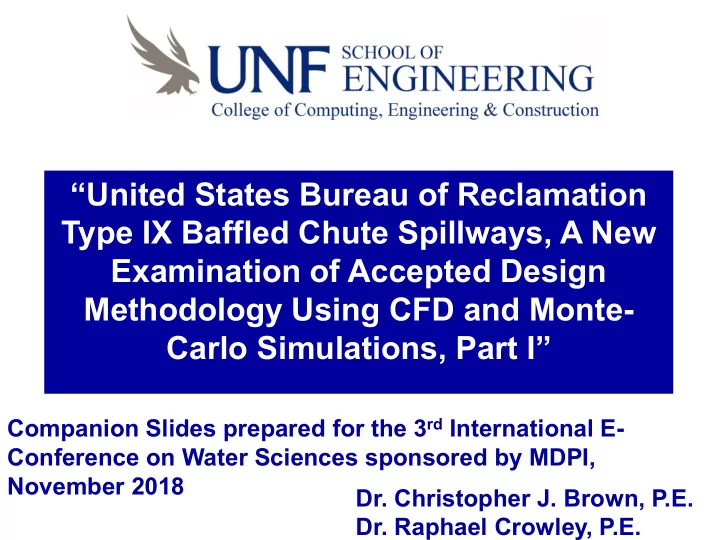

“United States Bureau of Reclamation Type IX Baffled Chute Spillways, A New Examination of Accepted Design Methodology Using CFD and Monte- Carlo Simulations, Part I” Companion Slides prepared for the 3 rd International E- Conference on Water Sciences sponsored by MDPI, November 2018 Dr. Christopher J. Brown, P.E. Dr. Raphael Crowley, P.E.
Prelim Study to Revise Design Procedures Study of Type IX baffled spillway design procedures using stochastic evaluations and computational fluid dynamics (CFD) simulations. General conclusion of the study is that current empirical/experience-based design procedure can result in a wide range of acceptable designs with some much more expensive than others. This is a companion presentation for a submitted paper by Christopher J. Brown, P.E. and Raphael Crowley P.E.
Prelim Study to Revise Design Procedures Type IX Baffled Spillway Schematic:
Prelim Study to Revise Design Procedures Example Type IX spillway: Example baffled chute spillway in Bozeman, Montana USA (photo from C. Brown).
Prelim Study to Revise Design Procedures Using the current design procedures published by the United States Bureau of Reclamation, the research team developed two separate spillway designs: The “minimalist” design starting with a baffle height of 80% of the chute critical depth; The “conservative” design starting with a baffle height of 90% of the chute critical depth; At the same time the research team simulated the original Bureau of Reclamation prototype spillway from Gila, AZ USA using a CFD model.
Prelim Study to Revise Design Procedures Method 1: Monte-Carlo Simulation of Chute Spillway starting from Bureau of Reclamation procedures; Simulation used reasonable range of variable uncertainties and: The “minimalist” design starting with a baffle height of 80% of the chute critical depth; The “conservative” design starting with a baffle height of 90% of the chute critical depth;
Prelim Study to Revise Design Procedures Method 2: CFD Simulation of original prototype Chute Spillway that was the basis for the current Bureau of Reclamation empirical design procedure; Idea was to develop “proof-of-concept” CFD simulation of spillway prototype and once model fully calibrated, revise the baffle design using Monte-Carlo simulation results for Minimalist and Conservative Designs; and, Revised design procedure ultimately the goal.
Prelim Study to Revise Design Procedures CFD Model Mesh: More than 3 million cells…
Prelim Study to Revise Design Procedures How about some results ?
Prelim Study to Revise Design Procedures Summary of Data and Analysis from Monte-Carlo Simulation: Table 1. Monte-Carlo simulation results for the minimalist and conservative designs. Design Minimalist Conservative Dimension (m) (m) Baffle Height 0.77 1 1.13 1 Minimum Training Wall 2.41 3.26 Height 1 10% and 90% range was used from the Monte-Carlo simulation.
Prelim Study to Revise Design Procedures Summary of Data and Analysis (Shear Stresses):
Prelim Study to Revise Design Procedures Summary of Data and Analysis (Near Bed Velocity):
Prelim Study to Revise Design Procedures Summary of Data and Analysis (Velocity Magnitude Cross Section along Spillway Centerline):
Prelim Study to Revise Design Procedures Summary of Data and Analysis (Velocity Vectors Cross Section along Spillway Centerline):
Prelim Study to Revise Design Procedures Future Research: Finish CFD Calibration and Validation of Prototype Simulation; Build two new CFD models using “minimalist” and “conservative” spillway designs as determined from stochastic study; Compare results of two new CFD models to the prototype CFD model to determine which is more efficient and more cost-effective; and, Develop recommended refinements to the current Type IX spillway design procedure.
Questions Thank you for the opportunity to provide this presentation. Chris Brown – christopher.j.brown@unf.edu; Or via phone: 01-(904)-620-2811 Raphael Crowley – rcrowley@unf.edu; Or via phone: 01-(904) 620-1847
Recommend
More recommend